

インタビューと構成・ブルース・オズボーン
翻訳・井上 佳子
編集・秋山 哲也
協力・増田 雄彦
Interview and text・Bruce Osborn
Translation・Yoshiko Inoue
Editing・Tetsuya Akiyama
Cooperation・Takahiko Masuda
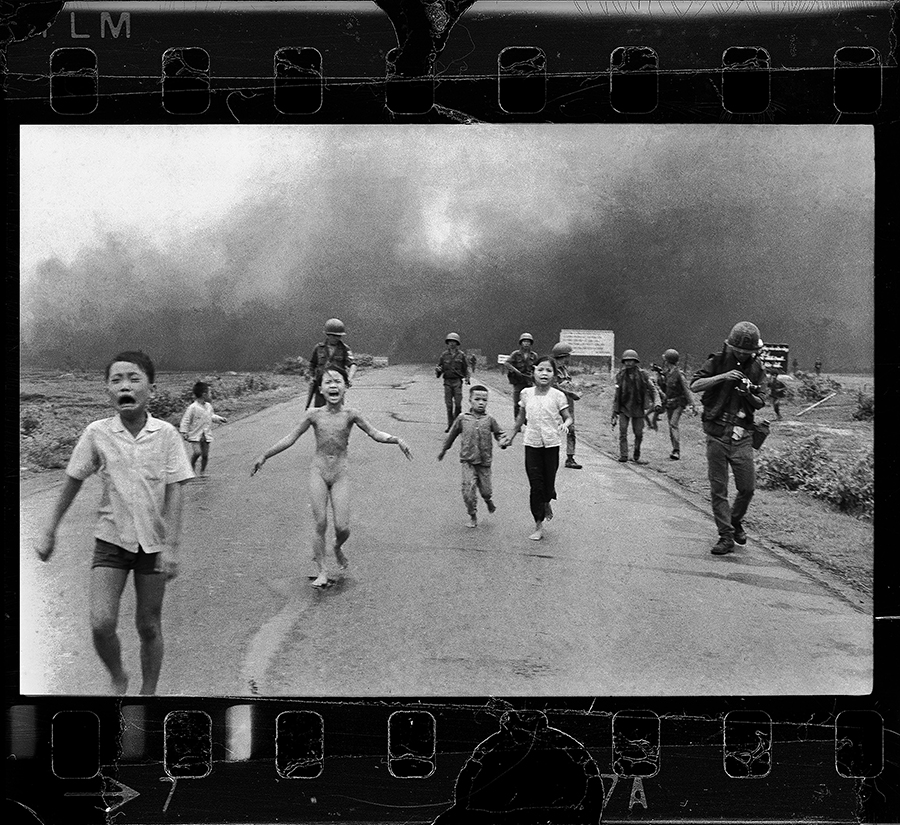
This year marks the 50th anniversary since Nick Ut took his Pulitzer Prize photo of a naked Kim Phúc fleeing with the other children from the napalm bombing. The following day published the photo was on the front pages of newspapers around the world and is considered to be one of the most unforgettable pictures of the twentieth century. Trang Bang Village (June 8, 1972) Photo by Nick UT / AP/ AFLO
ニック・ウトが、裸でナパーム弾爆撃から逃げるキム・フックの写真を撮影してから、今年で50年となります。この写真は撮影した翌日に世界中の新聞の一面として掲載され、ピューリッツァー賞も受賞。20世紀で最も忘れられない写真の1つとして、世界中の人々に平和の大切さを訴え続けています。(1972年6月8日、チャンバン村で) ニック・ウト撮影/AP/AFLO
-Brother who died photographing the Vietnam War-
Bruce Osborn (BO) : Please tell us about your family history and why you decided to become a photographer?
Nick Ut (NU) : My father was a farmer and there were 12 children in our family. I was the 10th child and very close to my brother, Huỳnh Thanh Mỹ, who was the 7th. He was a photographer for the Associated Press and my dream was to become a photographer like him. We were living together in Saigon and he was teaching me about cameras. I was heartbroken when my brother died while covering the war.
-ベトナム戦争取材で亡くなった兄-
ブルース・オズボーン(以下BO) : まず、家族の歴史と、写真家になろうと思った理由を教えていただけませんか。
ニック・ウト (以下NU) : 農夫の父には12人の子供がいました。私は10人目の子供で、7人目の兄、フイン・タン・ミーは、私の面倒をよく見てくれました。兄はAP通信のフォトグラファーで私のヒーローでした。私は彼と一緒にサイゴンに住んでおり、写真についてさまざまなことを教えてくれました。兄は、ベトナム戦争の取材中に死亡してしまいましたが、彼のような写真家になることが私の夢でした。
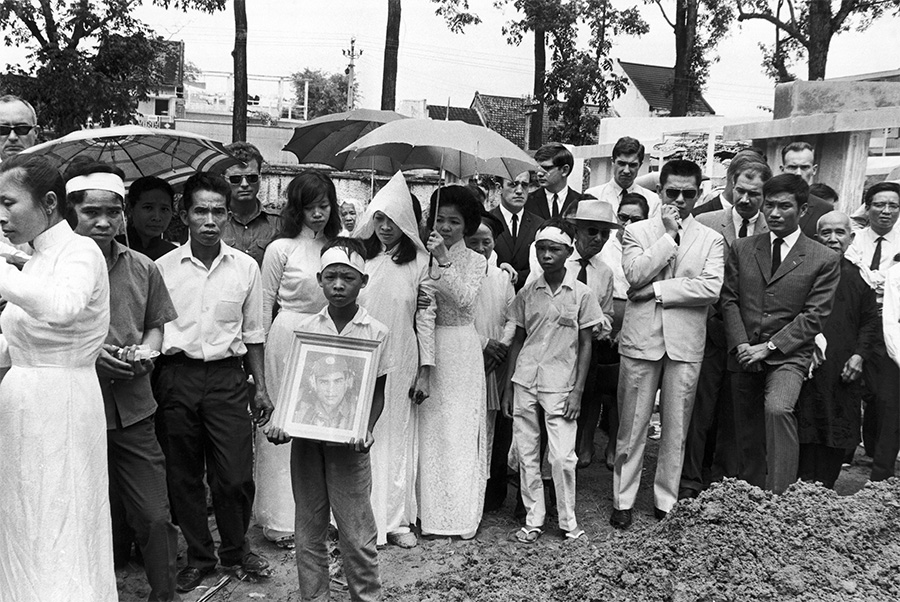
Newsmen and family members attend the funeral for AP photographer Huynh Thanh My. On the left side, holding photo with white headband, is his 16-year-old brother Nick Ut. (Oct. 1965) AP/AFLO
AP通信の写真家フイン・タン・ミーの葬儀には多くの新聞記者と家族が出席した。左前方で白い包帯を頭に巻いて写真を持っているのが、16歳のニック・ウト (1965年10月) AP / AFLO
-Welcome to the AP darkroom-
BO : How did you start working for AP?
NU : After my brother’s funeral, I went to AP and asked to be hired as a staff photographer. Everyone at the AP office in Saigon was very close to him, but they told me that I was too young and inexperienced for such a dangerous job. I was determined and a few weeks later asked again. This time they said, “Welcome to the AP, we’ll give you a job working in the darkroom.”
-AP通信社の暗室マンとして採用される-
BO : その後AP通信で働き始めることになりましたが、そのきっかけはなんだったんでしょうか?
NU : 兄が亡くなった後、AP通信に行き、スタッフ・フォトグラファーとして雇ってもらいたいとお願いしましたが、兄と親しかったサイゴンのAP通信のスタッフ達から、若すぎるうえに危険な仕事につくには経験が浅いと言われました。しかし、私の決心は揺ぎなかったので、数週間後にAPを再び尋ねて、働きたい意思を伝えたところ、歓迎の言葉とともに、暗室での仕事ができることになりました。
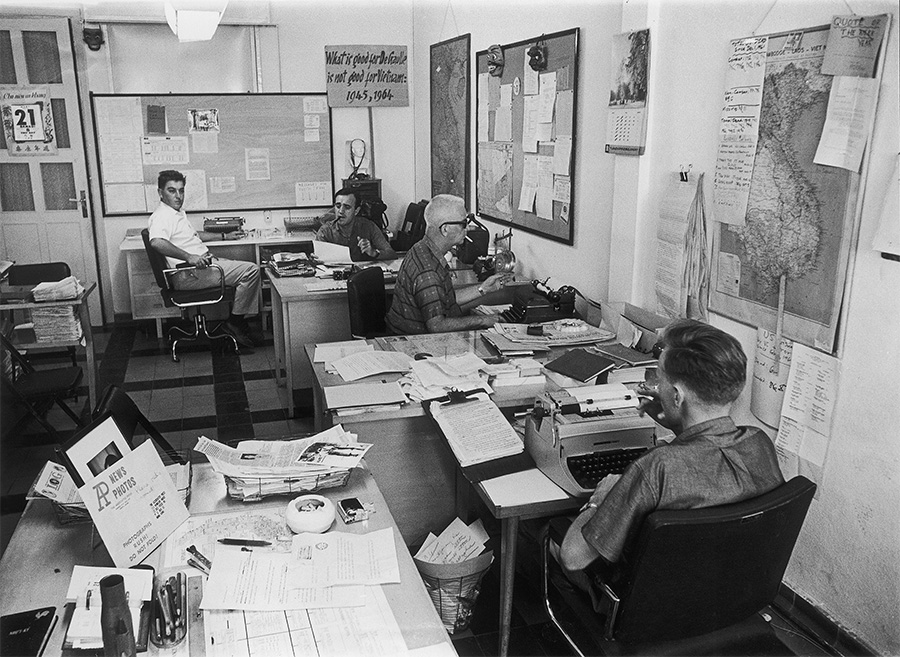
Associated Press Saigon Bureau, from left to right: photographer Horst Fans, correspondent Peter Arnett, chief of Southeast Asian Services Don Huth, and correspondent Malcolm Browne. (date & photographer unknown) AP/AFLO
AP通信サイゴンのオフィス風景。左から右へ、写真家ホースト・ファース、特派員ピーター・アーネット、東南アジアサービスのチーフ、ドン・ヒュース、特派員マルコム・ブラウン (日付不明)AP / AFLO
-Learning from the great photographers-
BO : What was it like to be working for AP during the war?
NU : I was 16 yr. and I loved processing the film of Horst Faas, Eddie Adams, Henri Huet, and the other photographers. I was very fortunate as there were no schools that taught photography in Vietnam, but I was learning from these great photographers. It was the best education I could have ever hoped for.
-最高の写真家に学んだ暗室-
BO : 戦争中にAP通信で働いた頃の話を聞かせてください?
NU : まだ16歳のころでした。ベトナムで取材をしていたホースト・ファース、エディー・アダムス、アンリ・ユエほか、大先輩の写真家の現像をするのが大好きでした。ベトナムには写真を教える学校がなかったのですが、暗室での仕事を通じて、素晴らしい写真家から学ぶことができたのは本当に幸運でした。私にとっての最高の教育だったと思っています。
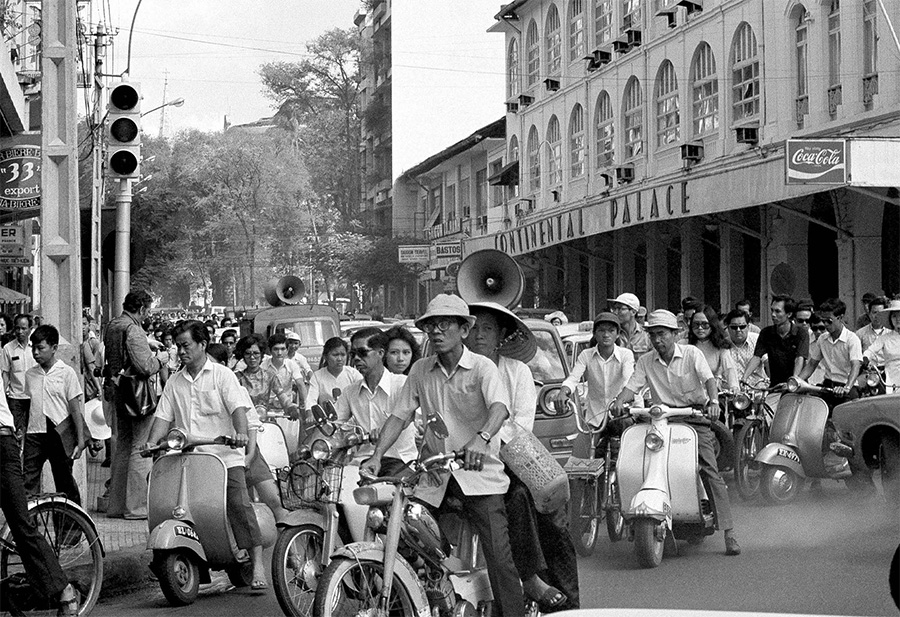
Traffic jam in downtown Saigon following an announcement of a 24-hour curfew in the capital.
(April 8, 1975) Photo by Nick UT /AP/AFLO
24時間の戒厳令が出され、家路を急ぐ人たちで渋滞するサイゴン市内(1975年4月8日) ニック・ウト撮影/AP/AFLO
-Reaching my dream by never giving up-
BO : How did you go from working in AP’s lab to becoming a staff photographer?
NU : I never gave up on my dream of being a photographer like my brother. Working in the AP’s lab, I was allowed to use their cameras and would go out taking photos in my free time. There was fighting in Saigon and the nearby villages, so I didn’t need to go far to gain experience as combat photographer. Afterwards, I’d show the photographers what I took and heard their advice. They could see that I was learning fast and after a few months, I asked my boss for assignments in addition to working in the lab.
-諦めなかった夢の対価-
BO : AP通信のラボで働いた後、正規のスタッフ・フォトグラファーになるまでの経緯を教えてください。
NU : 兄が亡くなってからも、兄のようなフォトグラファーになる夢をあきらめませんでした。 AP通信の暗室で働き始めたとき、幸運にもカメラを使用することを許可されたので、フリーな時間があると写真を撮ることができました。サイゴン周辺の村では戦闘が多かったので、フォトグラファーとして戦争現場を取材する経験を積むために遠くまで行く必要はありませんでした。撮った写真をプロの写真家に見てもらいアドバイスをしてもらうこともできましたので、暗室で働き始めて数カ月後には、私の写真を認めてくれたスタッフの推薦を受けることが出来たので、暗室で働きながら取材もしたいと上司にお願いしました。
-Getting my new name-
BO: How did you get the name Nick?
NU : My real name, Huynh Cong Ut, was difficult for people in the office to pronounce, so they decided to give me a nickname. Everyone was sitting around suggesting different ones when Henri Huet said, “I’ve got it, we’ll call him Nick” and from that day on, that was my name.
-ニック・ウトの誕生-
BO : ニックというニックネームになった経緯を教えてください。
NU : 本名のHuynh Cong Utは、オフィスの人が発音しにくいということで、ニックネームを付けることになりました。アンリ・ユエが「ニックはどう?」と言ってみんなが賛成。その時から、ニックが私の名前になりました。
-June 8, 1972 a date with destiny-
BO : Please tell us about the day you took the pulitzer Prize photo (Photo on top page)
NU : I heard the day before that the Viet Cong and North Vietnamese Regulars had attacked the village of Trang Bang and I got there early the following morning. The place was located on Highway One, the main road connecting the North and South Vietnam. It was always a dangerous place to travel and I passed thousands of refugees escaping the fighting along the way. When I got to Trang Bang, it looked deserted and I thought everyone must left when the fighting started. There were many craters where the bombs had exploded and I took a number of photos.
By noon, most of the photographers had already returned to Saigon and I was thinking it was time for me to head back too. Getting ready to leave, I took a last look at the pagoda and saw that a smoke grenade had been thrown then heard the sounds of airplanes. I was taking photos as the first plane unloaded its bombs followed by the second which dropped the napalm. I was a few hundred yards away, but felt so much heat coming from its fire. Thinking that no one was inside the pagoda, everyone was surprised to seeing a grandmother come running out of the fire holding a baby in her arms. There were around 10 cameramen there and we all rushed over to take photos. Then in the edge of my viewfinder, I noticed something else was moving in the smoke and focused on what was happening there. More people escaping from the fire and as they got closer, realized they were children and one of them was not wearing any cloths. When they ran by, I could see how badly the one girl had been burned and immediately stopped taking photos.
-運命の1972年6月8日-
BO : ピューリッツァー賞を受賞した写真を撮影した1972年6月8日の様子について教えてください。 注・フロントページの写真
NU : 南ベトナム解放民族戦線と北ベトナム軍がトランバンの村を攻撃したと聞いたので、翌日の朝早く、その現場に行ってみました。ベトナム北部と南部を結ぶ幹線道路 1号線沿いにある村で、戦火から逃げ惑っている 何千人もの難民を目撃したこともある危険な地域です。村には人の気配がなかったのでみんなすでに避難したものと思いました。投下された爆弾でできた穴がたくさんありましたので撮影をしました。
他のカメラマンのほとんどは、すでにサイゴンに戻っていましたし、私も何枚か写真を撮り、正午までにオフィスに戻るつもりでした。その時、少し離れた場所にあったパゴダの方を振り返ると、発煙弾が投げこまれたのが見えて飛行機の爆音が聞こえました。最初の飛行機が爆弾を投下し、続いて別の飛行機がナパーム弾を落とした時に、私は夢中で写真を撮り続けました。火元からは数百ヤードほど離れていましたが、非常に暑かったのを覚えています。パゴダには誰もいないと思っていたのですが、 おばあちゃんが死んだ赤ん坊を抱いて火事から逃げ出してきたので、そこにいた10人ぐらいのカメラマンは、急いで写真を撮り続けました。その時、煙の中で動いているものが目に入りました。火事から逃げ出してきた人々でした。私は彼らの写真を撮り始めました。そのうちの一人、衣服を身に着ていない女の子が、体中にひどく火傷を負っていたことに気づき、すぐに写真を撮ることをやめました。
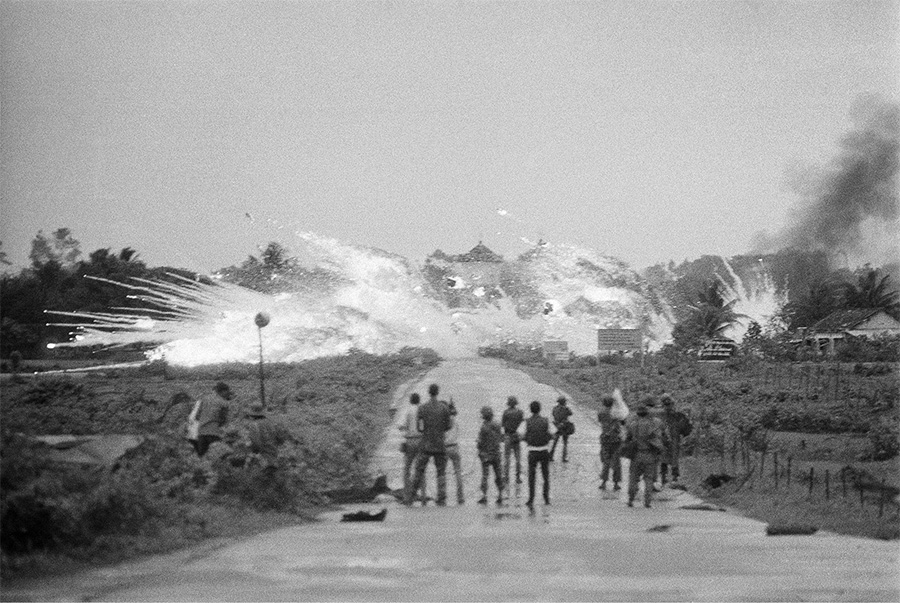
Napalm bombs explode in front of the Cao Dai temple in Trang Bang as soldiers and cameramen watch in the foreground.
(June 8, 1972) Photo by Nick UT/AP/AFLO
チャンバンのカオダイ教寺院の前で爆発したナパーム弾を見つめる兵士とカメラマン (1972年6月8日) ニック・ウト撮影/AP/AFLO
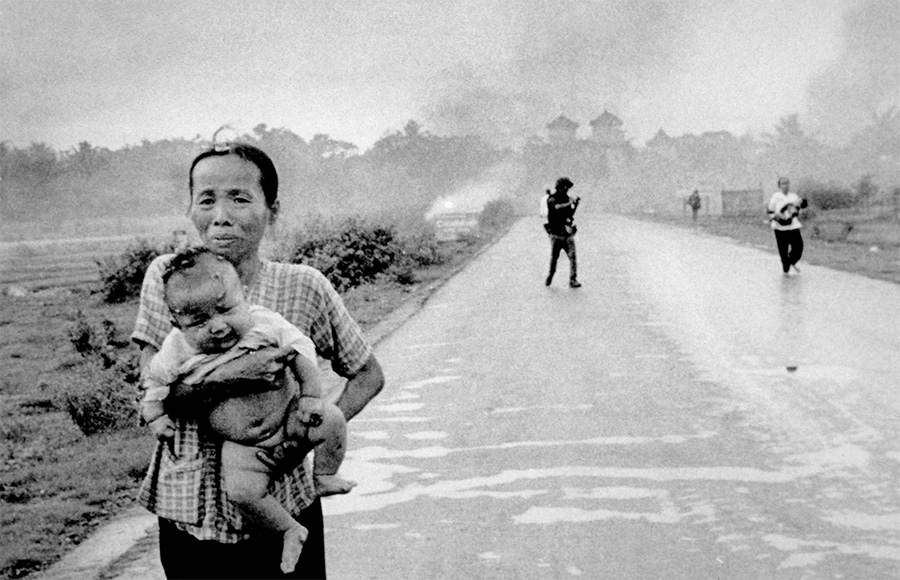
Anguished Vietnamese woman carries her dead grandson following the napalm bombing in Photo by Nick UT/AP/AFLO
ナパーム弾の攻撃で大やけどを負った赤ちゃんを抱え、必死に逃げるトランバン村の女性 (1972年6月8日) ニック・ウト撮影/AP/AFLO
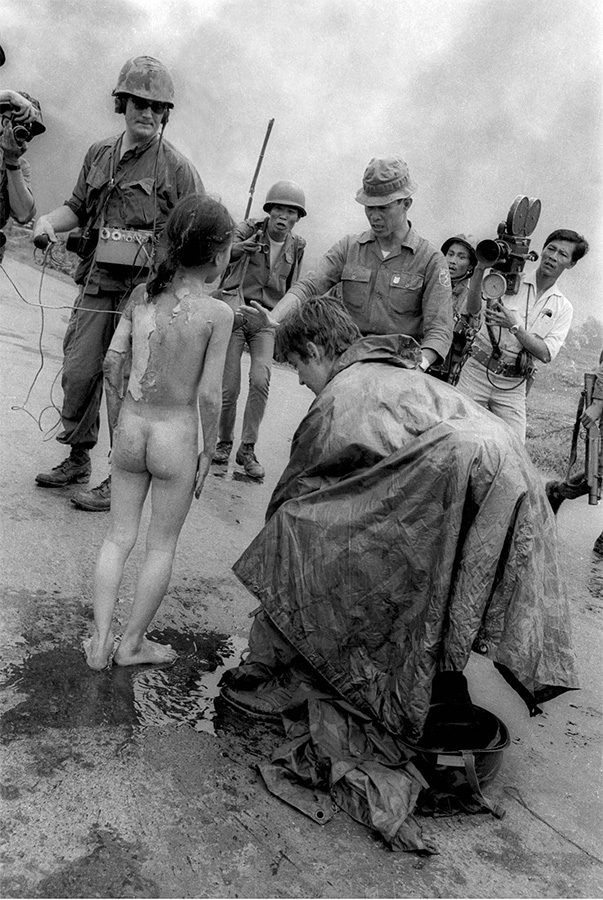
Television crews and South Vietnamese troops surrounding Kim Phuc are shocked to see the extent of her injuries. (June 8, 1972) Photo by Nick UT /AP/AFLO
キム・フックの火傷の悲惨さに衝撃を受けるテレビのクルーと南ベトナム軍兵士たち (1972年6月8日) ニック・ウト撮影/AP/AFLO
-A race to save her life-
BO : What happened next?
NU : Putting my cameras down,I began pouring water on Kim Phuc. I knew that if she didn’t get help quick, there was no way she’d survive. Covering her with an army raincoat, I got all children into the van and told my driver to go to the nearest hospital. Kim couldn’t sit and was laying on car floor crying. When we finally arrived, the staff said they already too many wounded and to take them to a Saigon hospital. Showing my AP media pass I said, “If any one of them dies, you’ll be in big trouble”. They immediately got moving and took Kim and the other children inside to treat their wounds. When I knew that they were being cared for, I headed back to the AP office.
-少女の救助に全力を尽くす-
BO : 撮影をやめたあと、どうされましたか?
NU : 私はカメラを置いて、キム・フックの体を冷やすために水をかけてあげました。すぐに行動をしないと、彼女の生存が危ぶまれると判断したからです。軍のレインコートで覆い、すべての子供たちをバンに乗せて、急いで最寄りの病院に行くように運転手に伝えました。キムは座ることもできず、車の床に横になって泣いていました。やっと病院に到着しましたが、負傷者が多すぎるという理由で入院を拒否され、サイゴンの別の病院に行くように言われました。私はAP通信のメディアパスを取り出して、「一人でも死なせたらたいへんな問題になりますよ」と言いました。医者と看護師はすぐにキムと他の子供たちを中に連れて行って、治療をはじめました。その様子を確認してから、私はAPオフィスに戻りました。
-“It’s such a powerful image, but …”-
BO : Did the Saigon Bureau know about the napalm bombing at Trang Bang when you got back to the office?
NU : Yes, they had heard and I said I have several rolls of black and white film needs to be processed. Ishizaki Jackson, the best darkroom person at AP, developed them and afterwards made a print of Kim Phuc and the other children running. Carl Robinson, the desk editor, said it’s such powerful image, but was concerned if it could be published because of the nudity. Everyone was talking about it, when Horst Faas got back. After seeing the picture and hearing what happened, Horst shouted “Why’s the picture still here? Write the caption and get it moving!” The photo was sent out in the afternoon and transmitted to Tokyo then to New York.
-「強烈な画像だが…」-
BO : APのオフィススタッフは、チャンバンでの出来事についてについて知っていましたか?
NU : 私が、チャンバンで撮った未現像のモノクロフィルムが数本あるということを言うと、APで最高の暗室の技術者であるイシザキ・ジャクソンはさっそく現像してプリントを作ってくれました。キム・フックと他の子供たちが走っているプリントを見たデスク編集者のカール・ロビンソンは、写真の印象を「強烈な画像だ!」と言いましたが、 ヌードの写真ということもあり、公開できるかどうかスタッフが決めかねていました。そこにホースト・ファースが戻ってきました。写真を見た彼は、「キャプションを書いて早く電送を!」と大声で指示。その日の午後には、東京とニューヨークに写真が電送されました。
-The photo that shocked the world-
BO : When did you realize the impact that this photo would have?
NU : I knew while I was taking it that this was going to be the most important picture I had ever taken. When the AP headquarters in New York saw the photo, they decided to make an exception regarding the publication of frontal nudity and it was distributed over the wire. In the next few hours, it was being published on the front pages of newspapers around the world and talked about on TV.
-世界を揺るがせた1枚の写真-
BO : いつ、この写真が与える影響の大きさに気づいたのですか?
NU : 撮っている時に、今まで撮った写真の中で一番重要な写真になることを実感してい ました。ニューヨークのAP通信本部は、ヌードの写真を公開することの例外を認め配信しました。結果として、数時間後に私が撮った写真は世界中の新聞のトップページに掲載され、テレビでも話題になりました。
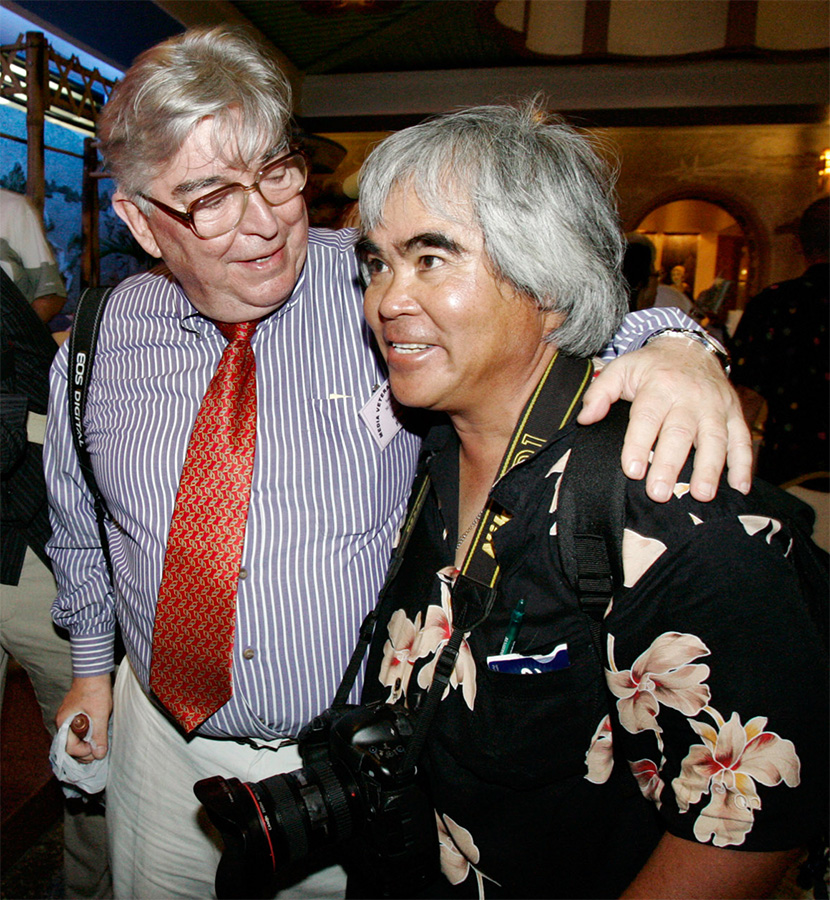
Legendary photojournalists, Nick Ut and Horst Faas, reconnect at a reunion party in Ho Chi Minh City. (May 10, 2012) Photo by Richard Vogel (AP/AFLO)
伝説的なフォトジャーナリスト、ニック・ウトとホースト・ファースがホーチミン市で行われた集まりで再会 リチャード・ボーゲル撮影/AP/AFLO
-Message from # 7-
BO : I heard that the picture was the 7th frame on the roll of film had a very special meaning for you?
NU : Yes, in Vietnamese families we refer to our siblings by their birth numbers. My brother, who taught me about photography was #7. He had always hoped to take a photo that would show the world the horror of war and bring an end to the fighting. When I saw that the photo was the 7th frame, I knew it was a message from him.
-最愛の兄「#7」のメッセージ-
BO : 配信された写真が、フィルムの7番目のフレーム画像だったということですね。あなたにとって特別な意味を持っていたとうかがいましたが?
NU : はい、ベトナムでは、兄弟を生まれ順で呼ぶことがあります。写真について教えてくれた最愛の兄は7番目の兄で「#7」と呼ばれていました。生前、兄は、世界中の人に戦争の恐ろしさが伝わる写真を撮って、戦いを終わらせたいと常に言っていましたので、発表された写真がフィルムの7枚目だとわかった時に、それは彼からのメッセージだと思いました。
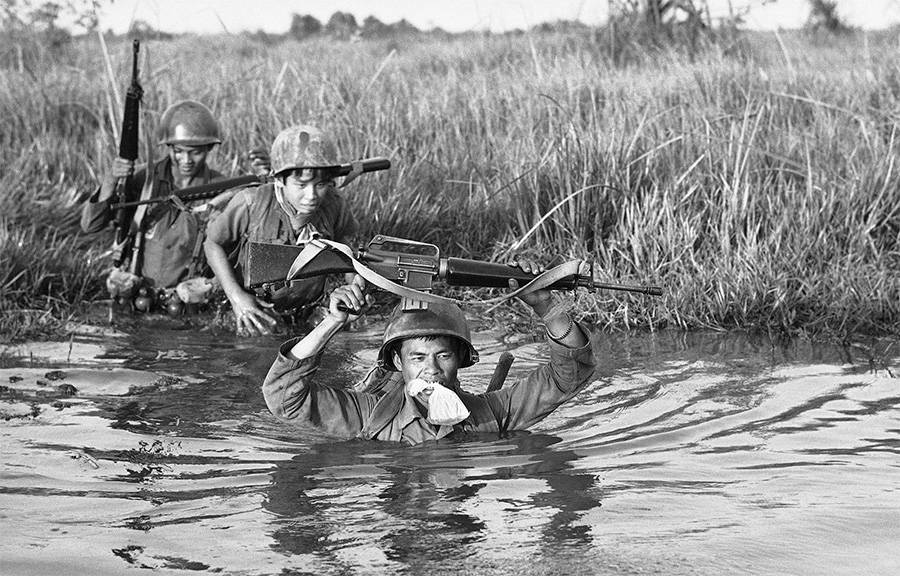
South Vietnamese soldier holds personal belongings in a plastic bag while crossing a stream in the Mekong Delta near the Cambodian border. (March 11, 1972) Photo by Nick UT/AP/AFLO
私物をビニール袋に入れてくわえ、カンボジア国境近くのベトナム・メコンデルタ地帯の湿地帯をゆく南ベトナム軍兵士(1972年3月11日) ニック・ウト撮影/AP/AFLO
-Always be ready-
BO : What kind of gear would you be carrying in your camera bag?
NU : I would pack 3 to 4 cameras with different length focal lenses. There were no zoom lenses back then and I didn’t want to miss a shot while changing lenses.
-大事な瞬間を見逃さないための心構え-
BO : いつもカメラバッグに入れている機材は?
NU : レンズ交換中にだいじな瞬間を見逃したくありませんでしたので、焦点距離の異なるレンズが付いたカメラを、常に3~4台持っていました。当時はズームレンズがありませんでしたので…
-Accepting my fate-
BO : You must have been nervous before going out on an assignment?
NU : As I was getting ready to leave, tried not to think too much about the possibility of getting hurt. I would tell myself; “You’re going die sometime, so does it matter if it was sooner or later?” I was young and didn’t let the fear of being killed stop me, but I didn’t want the responsibility of having a wife and children.
Who would be able to support them if I died? I was lucky, but many were not. Do you know the Japanese photographer Kyoichi Sawada? He was a good friend who didn’t make it.
-取材にあたっての覚悟-
BO : 撮影前の心がけは?きっと緊張していたと思いますが。
NU : 撮影に出かけるときはいつでも 「いつかということは分からないけど、遅かれ早かれいつか死ぬだろう」という覚悟を自分に言い聞かせていました。若かったので、死を恐れることはありませんでしたが、明日の命も保証されていない自分の仕事のことを考えると、結婚して妻や子供を養うようなことは望んでいませんでした。自分がいなくなったら家族は誰が養っていくのかという不安があったからです。
幸運にも、私は戦時下を生き延びることができましたが、不幸にも命を落とすことになってしまった多くの写真家がいました。戦地の取材中に死亡した日本の写真家、沢田教一のことを覚えていますか? 彼はとても良い友達でした。
-Carrying the wounds from the war-
BO : You must have been in many dangerous situations while take photos?
NU : Yes, I had a number of close calls. I was injured three times and still have shrapnel in one leg. On another occasion when I was in Laos, Henri Huet needed to get back to Saigon in a hurry and asked if he could have my seat on first helicopter leaving. When I got back to the office, they told me that the helicopter that Huet was on got shot down and no one survived.
-危険と隣り合わせた取材-
BO : 撮影中に危険な出来事があったと伺いましたが?
NU :はい、何度か危険な目にあっています。負傷も3回しましたし、片足にまだ榴散弾が残っています。わたしが乗るはずだったヘリコプターの席を、緊急でラオスからサイゴンに戻ることになったアンリ・ユエに譲ったことがありましたが、そのあと私が事務所に戻って聞いたのは、ユエが乗っていたヘリコプターが撃墜され全員がなくなったという驚きの知らせでした。
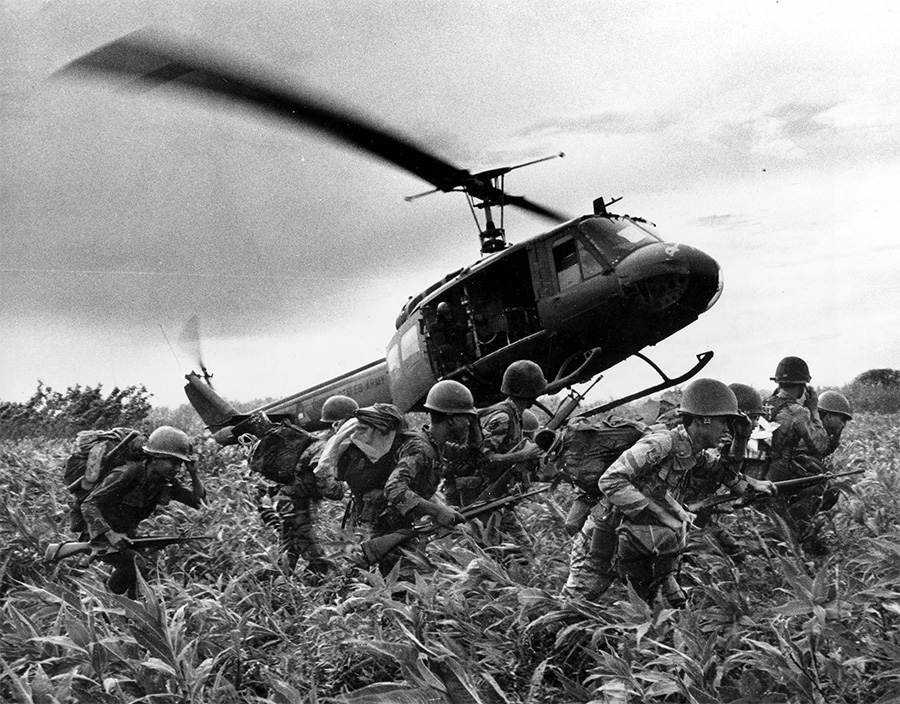
South Vietnamese Marines rush to a descending US Army helicopter after searching the area for Viet Cong in Prey-Veng province, Cambodia. (June 1970) Photo by Nick UT/AP/AFLO
カンボジアのプレイベン州でベトナム南部の統一戦線の捜索を終えた南ベトナム海兵隊が、その後に降下した米軍ヘリコプターに近寄る様子(1970年6月) ニック・ウト 撮影/ AP / AFLO
-Trauma from the war-
BO : I heard that you still suffer from PTSD (Post Traumatic Stress Disorder)?
NU : It is impossible to forget the war. Whenever I hear a helicopter or a loud sound my mind flashes back to the Vietnam War. I still have nightmares and wake up in the middle of the night. It is something that I will always have to live with.
-戦争からのトラウマ-
BO : 今でも PTSD(心的外傷後ストレス障害)に苦しんでいるとうかがいましたが?
NU : 戦争での経験を忘れることは不可能です。ヘリコプターや大きな音が聞こえるたびに、私の心はベトナム戦争の頃に戻っていきます。悪夢に見舞われ、夜中に目覚めることもしばしばあります。それは私にとって一生付き合っていくことだと覚悟しています。
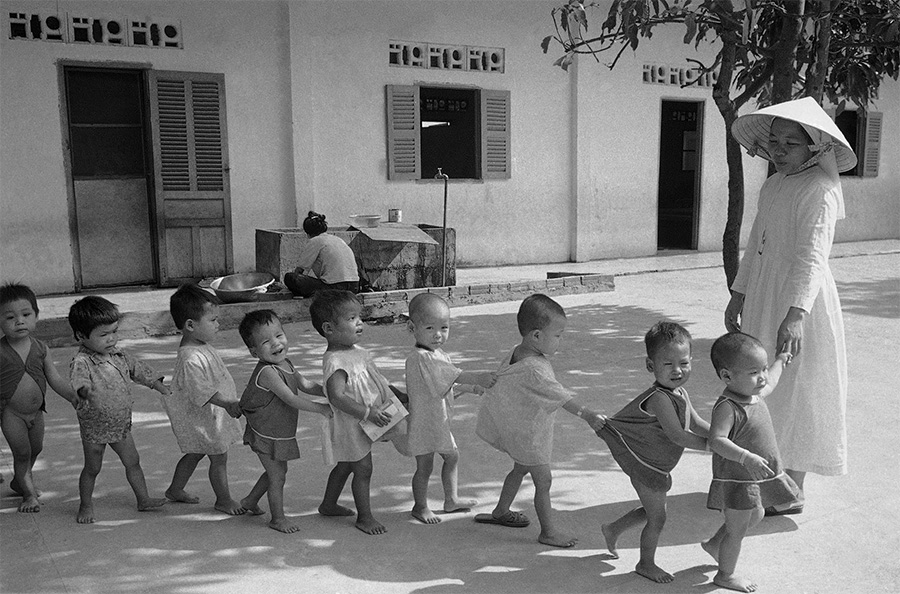
Catholic nun cares for children of dead or missing parents at the Minh Tri Orphanage in Saigon. (May 9, 1974) Photo by Nick UT/AP/AFLO
サイゴンにあるミントリ孤児院では、両親が亡くなったり行方不明になったりしたため孤児になった子供たちが暮らしている。面倒をみるのはカトリックの修道女たち (1974年5月9日) ニック・ウト撮影/AP/AFLO
-Reunion in Cuba-
BO : When was the first time to meet with Kim Phuc after leaving Vietnam?
NU : It was in 1989 when she was in Cuba and studying to be a nurse. AP heard that Kim Phuc was there and asked if I could to go for a story about us meeting again. She was so happy to see me and introduced her and fiancé who was Northern part of Vietnam. Later, I heard that when Kim and her husband were returning from their honeymoon in Soviet Union, they asked for asylum in Canada during a stopover in Toronto. I didn’t know how to contact her until 2000, when she found my telephone number and called. It was such a wonderful surprise and since then we talk all time. I feel like she is my daughter.
-キューバでの再会-
BO : キム・フックさんに久しぶりに会ったのはいつですか?
NU : フックさんがキューバに住んで看護師になるために勉強していたことをAP通信が知って、彼女に会って話を聞いてきてほしいと言われ、1989年に久しぶりに彼女に会いに行きました。彼女は私に会えたことをとても喜んでくれました。そして、ベトナム北部出身の婚約者を紹介してくれました。二人は結婚してソビエト連邦に新婚旅行に行った帰りに、飛行機の中継地となっていたトロントで途中降機し、カナダに亡命を求めたと聞きました。その後連絡が途絶えましたが、2000年に彼女は私の電話番号を見つけて電話をかけてくれました。それはとても素晴らしい驚きでした、そしてそれ以来、私たちは連絡を取り合っています。彼女は、実の娘のように思っています。
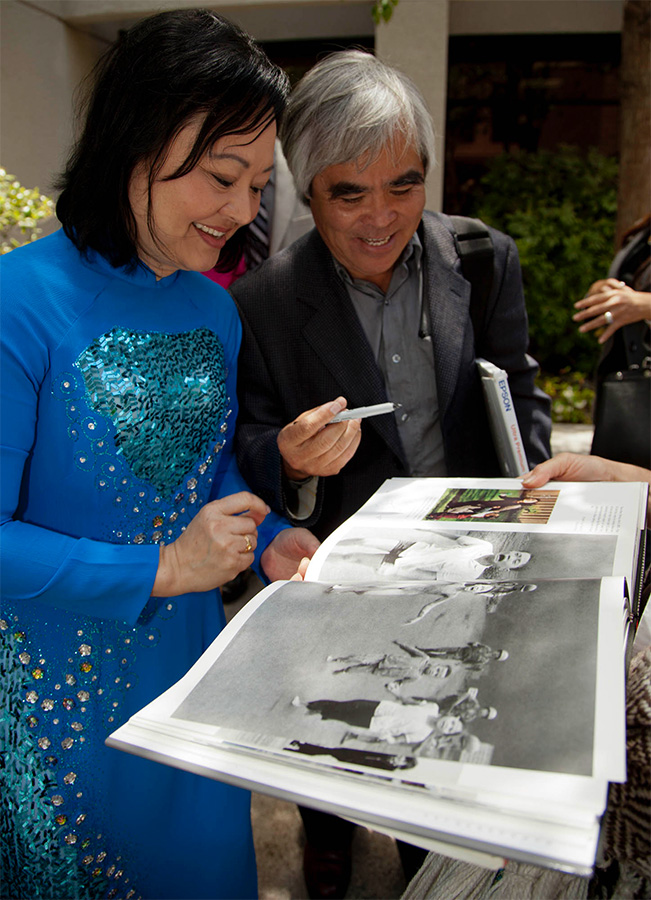
Nick Ut and Kim Phuc sign “The Napalm Girl ” photo at the Liberty Baptist Church in Newport Beach, California. (June 3, 2012) Photo by AP/AFLO
カリフォルニア州ニューポートビーチのリバティバプテスト教会で会ったニック・ウトさんとキム・フックさん。「ナパームガール」の写真集にそろって署名した(2012 年 6 月 3 日) Damian Dovarganes/AP / AFLO
-Wish for peace-
BO : What are Kim Phuc’s feelings about this photograph you took of her?
NU : Kim said that when she first saw photo in the hospital while she was being treated for her burns, she hated it. She was so embarrassed because she wasn’t wearing any cloths. Later when Kim realized its significance and her feelings changed. She now says she cherishes it for showing the atrocities of war.
She now heads the Kim Foundation, which provides medical and psychological support for children who are victims of war. As the UNESCO goodwill ambassador, she travels all over the world. Many times, we go together to speak at engagements.
This May we will be in Milan for my exhibition marking the 50th year since the photo was taken and afterwards, we will be meeting with the Pope.
-平和への願いを呼びかける-
BO : あなたが彼女を撮った写真について、キム・フックさんはどう思っていますか?
NU : 火傷の治療を受けている頃に病院で最初に写真を見たとき、キムはこの写真を嫌がっていたそうです。何も身に着けていなかったので恥ずかしかったそうですが、写真の重要性に気づいたとき、彼女は気持ちが変わったと言っていました。自分が写っているこの写真が戦争の残虐行為を人々に伝える大事な画像であると自覚している今は、この写真が大好きだと私に言ってくれます。
現在、戦争の犠牲となった子供たちに医学的および心理的支援を提供するキム財団の責任者となったキムは、ユネスコ親善大使としても世界中を飛び回っています。一緒に世界の各地を回って講演会をする機会もたくさんあります。そんな時には、戦争での体験を話して平和への願いを呼びかけます。
今年の5月は、写真を撮ってから50年目を迎える展覧会のためにミラノに行くことになっています。その後、ローマ教皇に謁見できるということです。
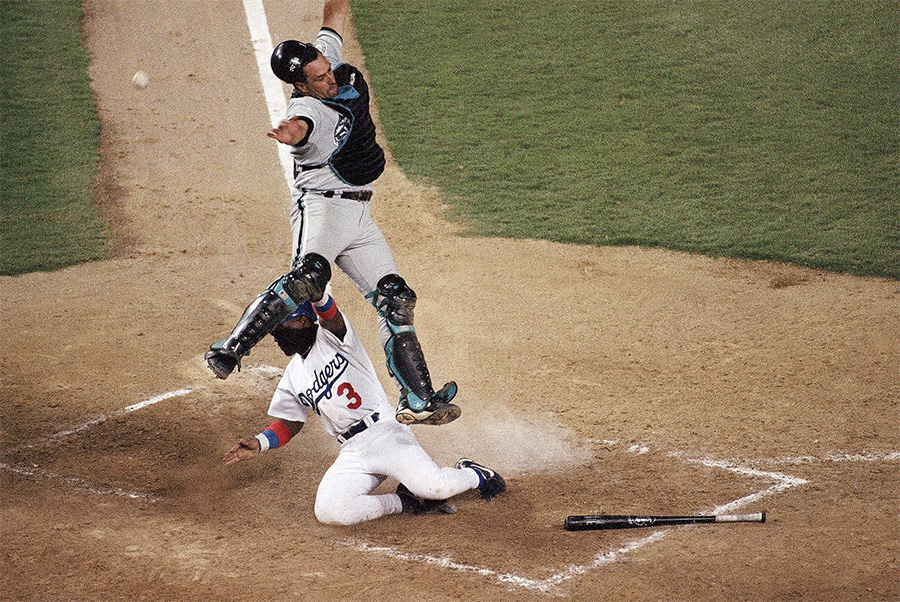
Florida Marlins catcher Bob Natal goes up for the ball as Los Angeles Dodger Chad Fonville Photo by Nick UT /AP/AFLO
フロリダ・マーリンズとロサンゼルス・ドジャースの同点場面での一瞬。キャッチャーのボブ・ネイトルが、必死でボールを受け止めようとすると同時に、ドジャースのチャド・フォンヴィルがベースに滑り込む(1996年7月30日) ニック・ウト撮影/AP/ AFLO
-After leaving Vietnam-
BO : What kind of work were you doing as at AP after leaving Vietnam?
NU : I left Vietnam on April 27, 1975, as the last of the AP staff were evacuated during the Fall of Saigon. My first assignment when I started working in the States was to photograph a baseball game at Angel Stadium. I had never seen played and didn’t understand the game. I kept asking the other photographers there, “Why were these people running all over the field?” Afterwards, I spent many hours in front of the TV watching baseball. Now I’m a big sports fan and enjoy taking all kinds of sports. A few years ago I was invited by the Angeles to put on their uniform and throw out the first pitch of the game.
-ベトナムを離れてから-
BO : ベトナムを離れた後、APでどのような仕事をしていましたか?
NU : APスタッフ全員が国外に避難したのを期に、私もベトナムを1975年4月27日に離れました。アメリカに住む許可が下りた後、私の最初の任務はエンゼルスタジアムで行われた野球の試合を撮影することでした。私は野球を見たことがなかったので、他のカメラマンに「選手たちがフィールド中をあちこち走っているのはなぜですか? 」とたずねたほど試合のことが理解できませんでしたし、どんな写真を撮ったらいいのかも見当がつきませんでした。それで、テレビを何時間も見て、野球について勉強しました。今では、野球やサッカー、バスケットボール、ホッケーなどのスポーツを楽しむ、大のスポーツファンです。数年前、私はエンジェルスから招待を受けて、彼らのユニフォームを着て始球式で投球するという光栄な経験をすることもできました。
-2 yr. in Tokyo-
BO : I heard that you were working in Japan too?
NU : After I got permission to live and work in the US, AP posted me in Tokyo. I was there for 2 years covering all the news from Japan. When I wasn’t working, I would get together with other photographers, many of whom I knew from Vietnam, and we’d to go out eating and drinking together. The people in Japan are so nice and I love the food. It’s still one of my favorite places in the world to visit. After that I asked to AP to be based back in Los Angeles.
-東京で過ごした2年間-
BO : 日本で仕事をしていた時期もあったと伺いましたが!
NU : アメリカでの居住権と仕事の許可を得た後、AP通信は私を東京に派遣しました。日本のすべてのニュースをカバーするためです。仕事をしていないときは、ベトナムで知り合ったカメラマンたちと一緒に食べたり飲んだりして楽しく過ごしました。日本の人たちはとても親切で、日本は私にとって世界でお気に入りの場所の1つです。日本の食べ物も大好きです。2年間の在日期間の勤務を終えて、その後、ロサンゼルスに拠点を移しました。
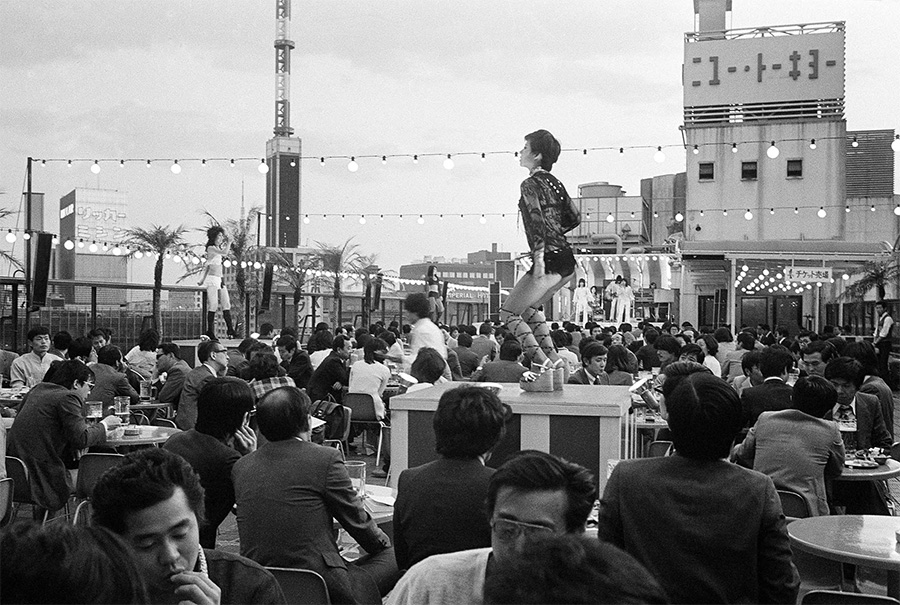
Beer drinkers are entertained by a go-go dancers at a rooftop beer garden in Tokyo. (May 22,1977) Photo by Nick UT (AP/AFLO)
東京の屋上ビアホールでゴーゴーダンサーの踊りを楽しみながらビールを飲む人たち (1977年5月22日) ニック・ウト撮影/AP/AFLO
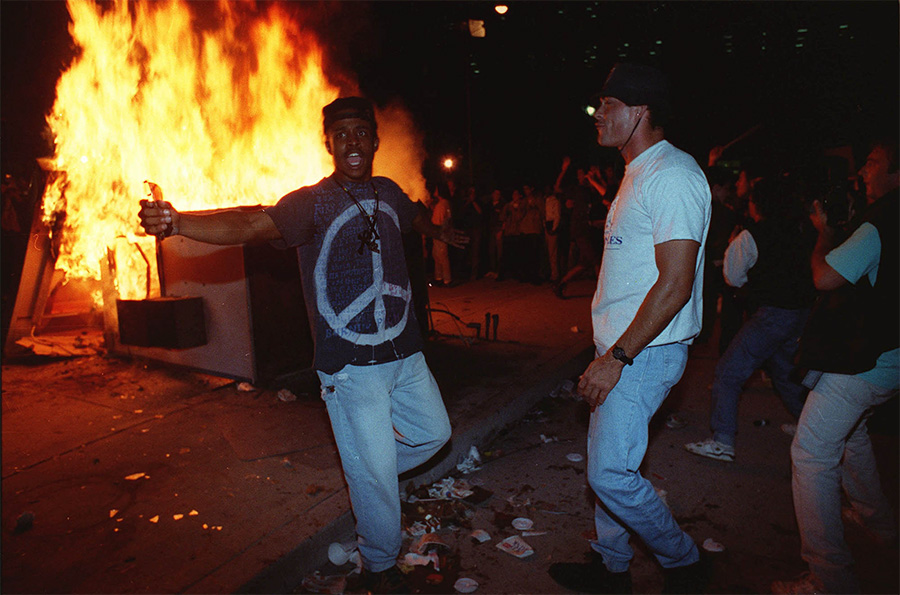
Violence erupts in downtown Los Angeles following the police officers acquittals in Rodney
King trial Photo by Nick UT /AP/AFLO
ロドニーキングの裁判で警察官が無罪となった後、ロサンゼルスのダウンタウンで暴力が勃発するようになった(1992年4月29日) ニック・ウト撮影/AP/AFLO
-My experience in Los Angeles-
BO : What kind of stories were you taking in Los Angeles?
NU : I was covering all types of news from sports to famous court trials like the OJ Simpson, fires, and other disasters. It was very different from being a war photographer, but I could always find something interesting to take. It was also much safer with the exception of when I was covering Los Angeles riots in 1992. In all my years as a combat photographer, that was the first time to have someone point a gun directly in my face. Fortunately, he didn’t shoot me and after that, decided it would be safer to stay close to National Guards. (April 29, 1992)
-ロサンゼルスでの経験-
BO : ロサンゼルスではどんな取材をしましたか?
NU : スポーツ、OJシンプソンのような有名な法廷裁判のケース、火事やその他の災害など、あらゆる種類のニュースを取材しました。戦場フォトグラファーとはかなり違いましたが、いつも面白い発見をして取材を楽しんでいました。アメリカでの取材現場は、戦闘フォトグラファーとしてベトナムにいた頃よりもはるかに安全でしたが、1982年にロサンゼルス暴動を取材した時、顔に直接銃を向けられたということがありました。幸いなことに彼は私を撃ちませんでしたが、その経験から、取材中は州兵の近くにいるのが安全であるということを学びました。
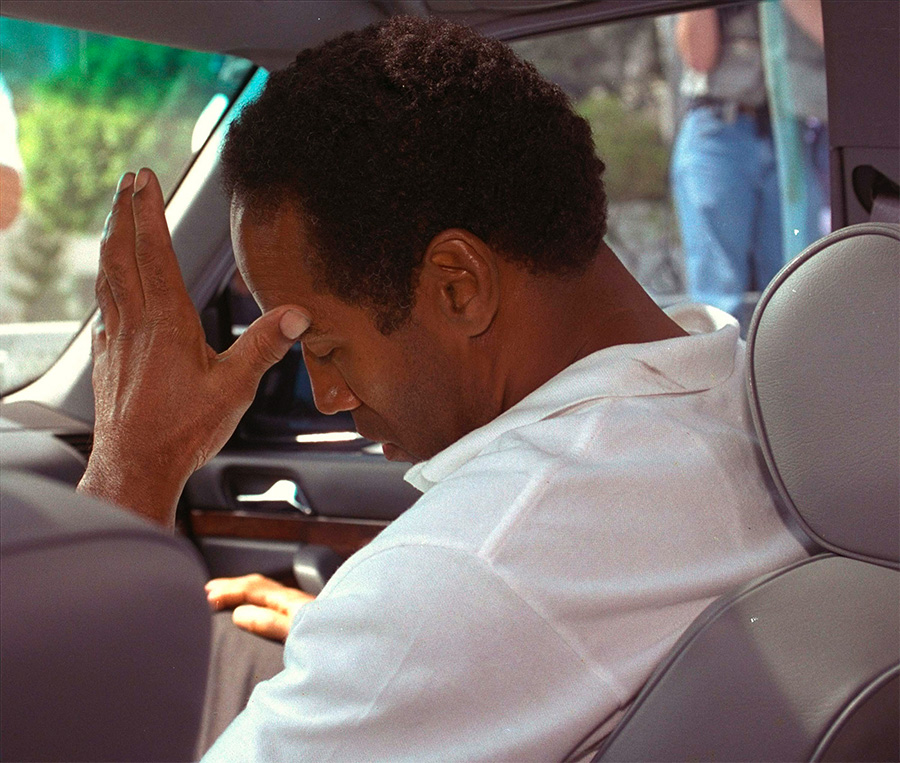
Former pro running back OJ Simpson hangs his head after being questioned by Los Angeles Police regarding the stabbing deaths of his ex-wife, Nicole Brown Simpson, and an unidentified 26-year-old man. (June 13, 1994) Photo by Nick UT (AP/AFLO)
アメリカンフットボールで活躍した OJシンプソン。元妻のニコール・ブラウン・シンプソンと26歳の交際相手の男性が刺殺された事件についてロサンゼルス警察から取り調べを受けた後のうなだれていた様子 (1994年6月13日) ニック・ウト撮影/AP/AFLO
-Shooting the stars-
BO : What is it like taking Hollywood celebrities?
NU : I love photographing celebrities. I have taken many big stars like Zaza Gabor, Michael Jackson, Robin Williams, and always get along with them, especially when they hear I took the “Napalm Girl” photo. Even Marlon Brando, who was upset to see me taking photos at his son’s murder trial,but after finding out that I shot that famous picture, he put his arm around me and we left the courtroom together.
-ハリウッドスターとの交流-
BO : ハリウッドの有名人もたくさん撮影していますね?
NU : 有名人の写真を撮るのは楽しいです。ザザ・ガボール、マイケル・ジャクソン、ロビン・ウィリアムズなど、多くの大スターの写真を撮りました。「ナパーム弾の少女」の写真を撮ったカメラマンだということを知ると、親しみを感じてもらえました。 マーロン・ブランドが、殺人を犯した息子の裁判で出廷したときにも、取材中の私が「ナパーム弾の少女」を撮ったカメラマンだと知ると、メディア嫌いで知られる彼が 「顔だけを撮って全身を撮らないように」と声をかけてきました。それから、私の肩に腕を回して法廷から一緒に出て行きましたが、その様子に驚いた人たちが写真を撮っていたのを覚えています。
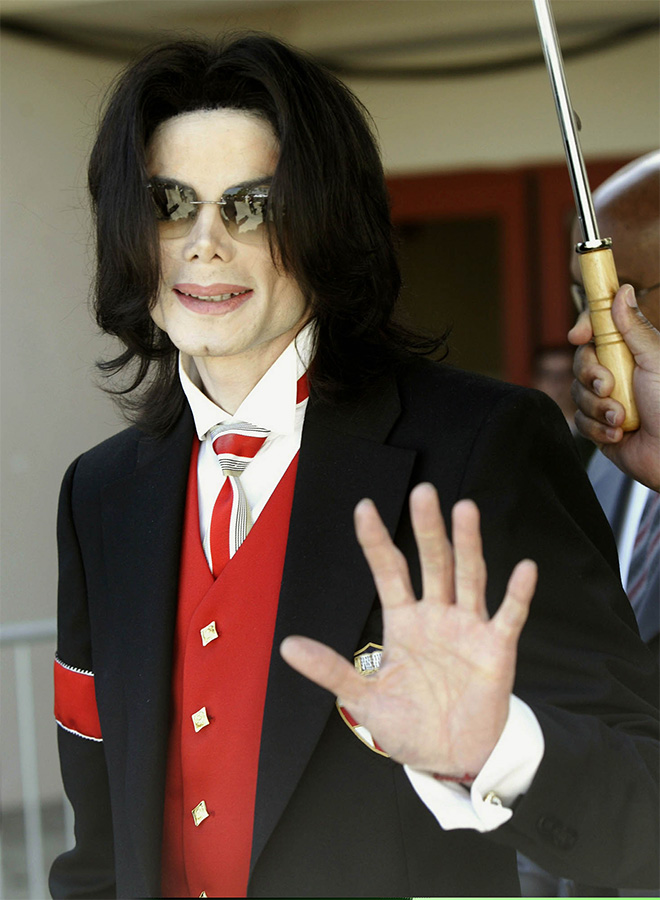
Michael Jackson leaves Santa Barbara County Court at his child molestation trial in Santa Maria, California (March 28, 2005) Photo by Nick UT/AP/AFLO
子どもへの性的虐待の裁判で供述を終え、サンタ・バーバラ郡裁判所を出るマイケル・ジャクソン被告(2005年3月28日) ニック・ウト撮影/AP/AFLO
-Lessons learned on the battlefield-
BO : Your picture are always so well framed.
NU : I believe this is something I learned from being with the AP photographers in Vietnam. Always have your camera with you and frame your photo to show only what’s important to tell the story. Even though I have stopped working as a press photographer, I still carry 2 or 3 cameras with me at all times. I use a Nikon for action photos and a Leica to take portraits and other shots when I have more time to compose. My favorite lens at the moment is a Sigma 60 mm to 600 mm zoom.
-戦場の取材経験が今役立つ-
BO : 写真のフレーミングがいつも素晴らしいですね。
NU : サイゴンのAPでフィルムの処理をしていた時に学んだんでしょうか? いろいろな写真家が撮った写真を見ることで学ぶことが多かったです。ストーリーを伝えるために重要なことだけを切り取るように、被写体をフレームに収めることは常に意識しています。プレスのカメラマンとしての仕事をやめましたが、シャッターチャンスを逃したくないので、いつも2、3台のカメラを持っています。アクション写真にはニコン一眼レフカメラを使用し、ポートレートなどの急いでいない写真にはライカを使用しています。現時点で私のお気に入りのレンズはシグマ60mm~600mmズームです。
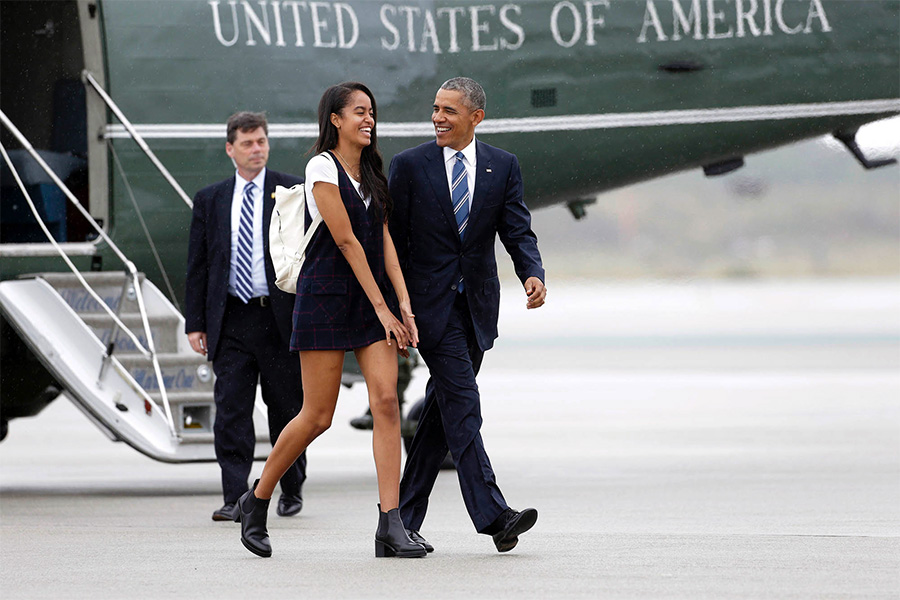
President Barack Obama and daughter Malia departing Marine One and head for Air Force One during their two-day fundraising swing through California. (April 8, 2016) Photo by Nick UT/AP/AFLO
米大統領選の基金を募るツアーでカリフォルニア州を訪れたオバマ大統領と娘のマリアさん。大統領専用ヘリのマリーンワンを降りて専用機のエアフォースワンに向かうところ(2016年4月8日) ニック・ウト撮影/AP/AFLO

Paris Hilton in Los Angeles. © Nick UT
パリス・ヒルトンをロサンゼルスで ©Nick UT
-Happy memories of returning home-
BO : What is it like when you go back to Vietnam?
NU : Everyone knows my face and I feel like a movie star. I’m in the newspapers and interviewed on TV programs everyday about my “Napalm Girl” photo and other things.
-嬉しかった帰郷での思い出-
BO : ベトナムに帰ったときの印象を教えてください。
NU : みんなが私の顔を知っていて、まるで映画スターのようでした。新聞に掲載されたり、毎日のようにテレビ番組で「ナパーム弾の少女」の写真が紹介されたりインタビューされました。
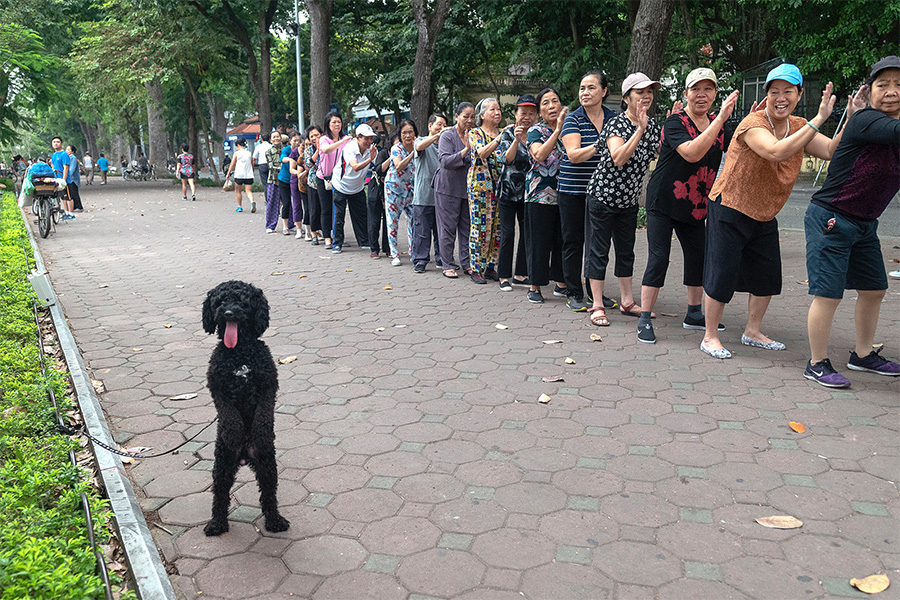
A dog imitates people exercising in Hanoi, Vietnam. Hoan Kiem Lake, Hanoi, Vietnam. © Nick UT
運動している人々のまねをする犬(ベトナム・ハノイ近郊のホアンキエム湖で) ©Nick UT
-Time to work on my own projects-
BO : Why did you stop working for AP and what are you taking now?
NU : Most of my AP jobs were in Los Angeles and I wanted have more time to travel and pursue personal projects. I really like taking photos of birds, whales, and other animals in their natural habitat. Recently, I returned from a trip to South America and Antarctica.
I went with my good friend and photographer Mark Edward Harris and we stayed at a great place in Chile called The Singular Patagonia then flew to Antarctica to board an Antarctica 21 ship called Magellan Explorer. It was my first time to go there and I took lots of penguins and other wildlife photos. It was one of the most amazing experiences of my life!
-興味の赴くままに-
BO : AP通信を退職してからは、どのような仕事をされていますか?
NU : アメリカに住むようになってからのAP通信の仕事は、ロサンゼルスで撮影することがほとんどでしたが、今は、個人的なプロジェクトの撮影で旅をすることが多いです。自然界に生息する鳥やクジラなど、動物の写真を撮るのが本当に好きです。
親しい友人の一人、写真家のマーク・エドワード・ハリスさんと一緒に南アメリカと南極に行って、つい最近戻ってきたところです。チリのThe Singular Patagoniaという素晴らしい場所に滞在後、飛行機で移動。マゼランエクスプローラー号Antarctica 21という船に乗船して南極大陸に初めての旅をしました。 ペンギンやクジラなどの写真をたくさん撮影することができて、人生で最も素晴らしい経験の1つでした!
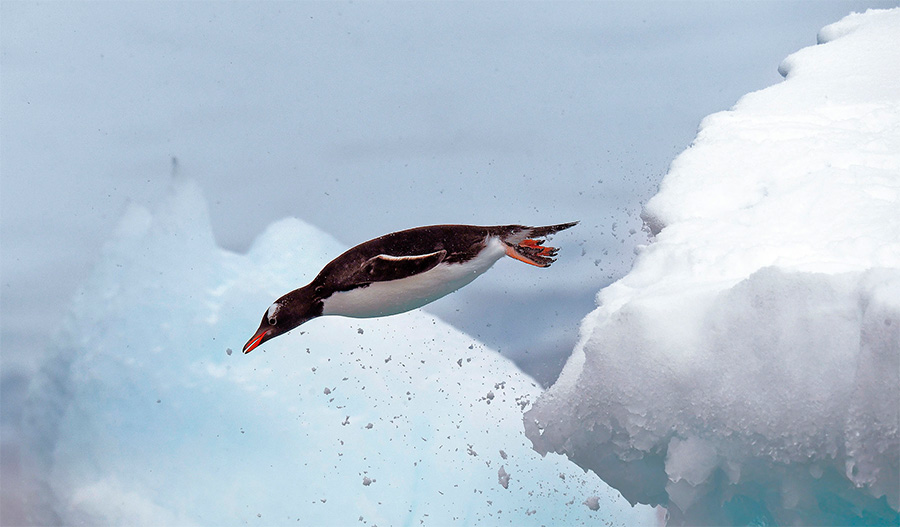
Gentoo Penguin jumps off an iceberg into Fournier Bay, Antarctica. 2021 Antarctic © Nick UT
氷山から南極のフルニエ湾に飛び込むジェンツーペンギン 2021 ©Nick UT
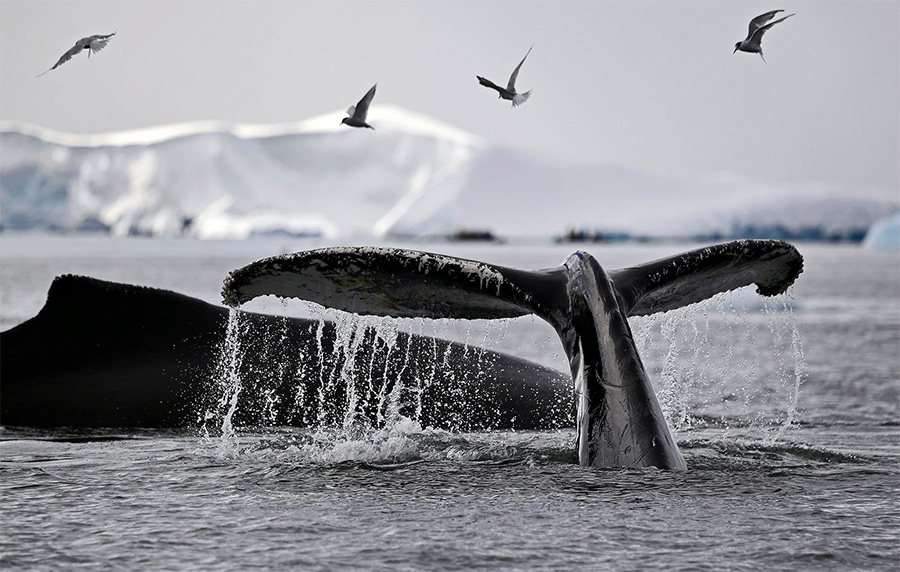
Humpback whales and Antarctic terns, Fournier Bay, Antarctica. 2021 © Nick UT
南極のフルニエ湾で撮影したザトウクジラとナンキョクアジサシ 2021©Nick UT
-My fun challenge-
BO : I heard you have another interesting subject that you like taking photos of?
NU : I am a member of a group called the “Lunartics” . We get together when there is a full moon and photograph planes as they fly in front of it. Taking a perfectly framed photo is really difficult, but I have a lot of fun trying.
-楽しい挑戦-
BO : 他にも撮りたいテーマがあるとうかがいましたが?
NU : 満月の夜に集まって、飛行機が月の前を飛ぶ写真を撮る「Lunatics」というグループのメンバーの一員です。飛行機が月の中心になるようにフレーミングした写真を撮るのは本当に難しいですが、楽しんで挑戦しています。
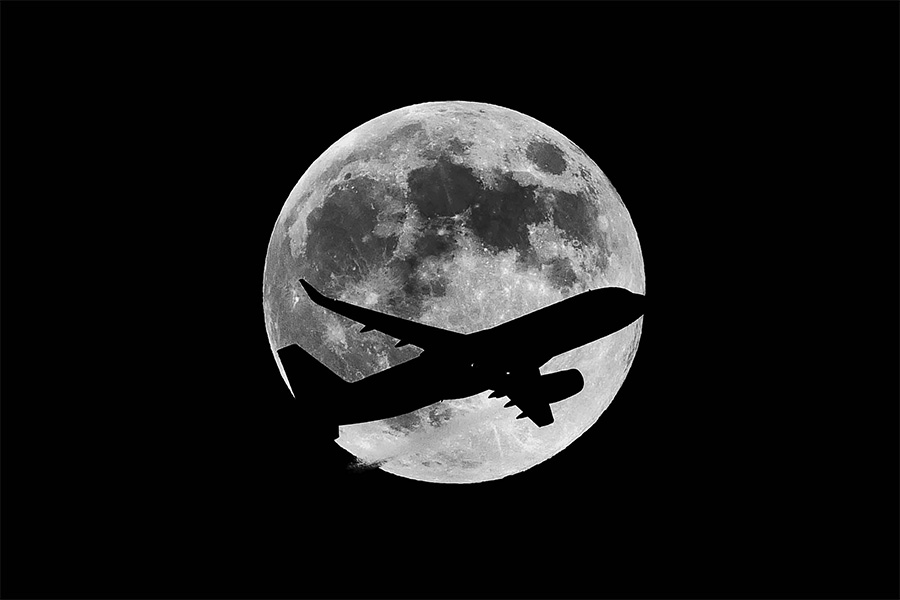
A plane passes in front of the moon. ©Nick UT
月の前を通過する飛行機 ©ニック・ウト
ニック・ウト写真展「From Hell to Hollywood and Beyond」
会 期:2022年5月7日(土)〜6月3日(金)
時 間:平日・土曜 10:30〜22:00/日祝休
場 所:日本外国特派員協会 ウェブサイト
東京都 千代田区 丸の内 3-2-3 丸の内二重橋ビル5階
